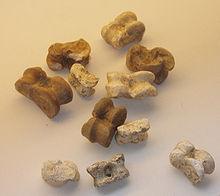Astragalus oracle
The astragal oracle is an old mantic method for obtaining oracle sayings by repeatedly dicing the cuboid ankle bones of certain mammals (especially cloven-hoofed animals such as pigs , goats and sheep ). The Greeks called this bone astragalus ( Greek ἀστράγαλος ), and the Romans called it talus (from which the name talisman may be derived, since these bones were also carried as a lucky charm).
The beginning of the use of such bones for oracle purposes cannot be precisely determined, but is certainly very old, as astragals were already known to the Egyptians.
Each of the four long sides of the cuboid was assigned a numerical value. Because the sides are not evenly shaped, the sides have an unequal probability of appearing when thrown . The Latin names of the pages are:
- supinum ("backward sloping surface", numerical value: 3)
- pronum ("forward sloping surface", numerical value: 4)
- planum ("level", numerical value: 1)
- tortuosum ("curved surface", numerical value: 6)
Traditionally the oracle was determined by 5 throws, resulting in a total between 5 (= "1,1,1,1,1") and 30 (= "6,6,6,6,6"). The total values 6 and 29 cannot occur because the next higher after 5 is 7 (= "1,1,1,1,3) and the next lower after 30 is 28 (=" 4,6,6,6,6 " If only the total value was considered, there were 24 possible results, which were assigned to the letters of the Greek alphabet in reverse order , i.e. 30 corresponded to the first letter alpha , 28 corresponded to beta etc. If the thrown numbers were now one letter assigned, the interpretation of the Greek letter oracle was used, which offered an oracle saying for each letter.The alpha, the highest value, had the saying: God says you will do everything happily.
If not only the sum of the numerical values is considered, but the combinations of the numerical values are differentiated, i. H. "1,1,1,1,6" and "1,1,1,3,4" (both with a total of 10) are differentiated, so there is
possible combinations. An oracle was assigned to each of these combinations. The lists of these oracles have been preserved because the oracle was apparently so popular that the lists were carved in stone and placed in the marketplace. Often the cuboids with the oracle lists also carried a statue of Hermes , the patron god of these oracles. An oracle thus preserved reads:
- 1,1,1,6,4 [Sum:] 13. Three ones fall from Aphrodite, then a six, and the fifth a four: Travel wherever you want! You will come home happy, you will find and do what you consider in your heart. But pray to Aphrodite and the son of Maia [Hermes].
The game of chance , which is particularly popular with the Romans and is played with four astragals, is called Astragaloi .
literature
- Franz Heinevetter: Cube and letter oracle in Greece and Asia Minor. Dissertation. Breslau 1912 full text
- Johannes Nollé : South Asia Minor Losoracles in the Roman Empire. In: Antike Welt 18, 3 (1987) pp. 41-49
- Johannes Nollé: Minor Asian Losoracles. Astragalus and alphabetic resmologies of the high imperial oracle renaissance , Vestigia vol. 57, CH Beck, Munich 2007, ISBN 978-3-406-56210-5
Individual evidence
- ^ Veit Rosenberger : Greek oracles. A cultural story. Scientific Book Society, Darmstadt 2001. S. 42f.


